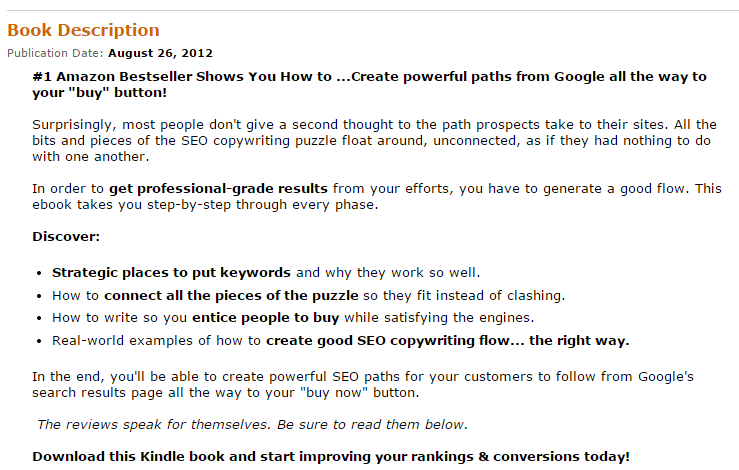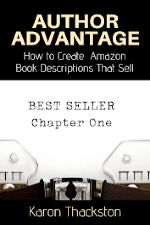 You’ve done it! You’ve published your book (or someone else published it for you) and you’ve listed it on the largest book-selling website on earth: Amazon. One day later; no sales. Two weeks later; no sales. A month later; one sale. What’s going on?
You’ve done it! You’ve published your book (or someone else published it for you) and you’ve listed it on the largest book-selling website on earth: Amazon. One day later; no sales. Two weeks later; no sales. A month later; one sale. What’s going on?
If Amazon is all that and more when it comes to bookselling, why is your publication growing cobwebs while sitting on their virtual shelf? Because Amazon’s size and popularity are like a leprechaun on St. Patty’s Day. It can be the pot of gold at the end of a rainbow or it can frustrate you with what seems like pranks designed to drive you mad!
When you read these stats, what two thoughts comes to mind?

I think:
(1) Awesome sales opportunity! and
(2) TONS of competition.
The answer to taking advantage of the first and overcoming the second is the same: creating a compelling book description. Combine this with a headline that captivates readers’ attention and you’ve got the foundation for converting more shoppers into buyers as you drive traffic to your book’s sales page on Amazon.
4 Step Template For Developing Enticing Book Descriptions
As I mention in my book, Author Advantage: How To Create Amazon Book Descriptions That Sell, “With a few exceptions (such as reference books), the idea is to use the book description to intensify the customer’s interest in what your book is about.” While there are dozens (if not hundreds) of ways to write descriptions, this is an easy template to follow for most books.
1. Create A Headline
Your Author Central account (which you should set up today if you don’t already have one) gives you the ability to format your physical and/or Kindle book listing with bold, italics and bullet points/numbered lists.
I like to start with a bolded headline that conveys some message of results and/or piques curiosity. Here’s one of my best-selling Kindle books.
 Because this Kindle book has been a #1 Amazon Bestseller in the past, I can legitimately use that phrasing. I followed that with some of the end results readers might receive after reading and implementing the information the book offered: the ability to create powerful paths from Google all the way to their “buy” buttons.
Because this Kindle book has been a #1 Amazon Bestseller in the past, I can legitimately use that phrasing. I followed that with some of the end results readers might receive after reading and implementing the information the book offered: the ability to create powerful paths from Google all the way to their “buy” buttons.
For autobiographies, you would take the same approach, but the end result might be an inside look at your life, gleaning vital information from your mistakes and victories, or maybe just a good laugh! This autobiography by comedian Billy Crystal is a good example.

2. Use Power Words And Phrases
Choose your words carefully when creating your book description. This is one of the most influential elements of your Amazon book listing. Ordinary and informative simply won’t do. Your goal should be to enlighten, engage and compel shoppers.
Paint a picture for your customers. In the examples I gave in #1, we have the following:
• Bestseller
• Powerful
• Professional-Grade
• Strategic
• Clashing
• Hilarious
• Heartfelt
• Favorite
• Remarkable
What if those titles had read:
“This Kindle book shows you how to create paths from Google to your “buy” button”
and
“Funny and sincere observations on aging from one of America’s comedians…”
Just doesn’t pack the same intrigue or punch, does it?
Download your…
Time-Tested, Proven Marketing Strategies
That Actually Work
A handy checklist set that helps you drive traffic, make more money & spend less time doing it.

I understand that I will also receive weekly articles & videos plus periodic discounts, product notices & more. I can unsubscribe at any time.
Break out your thesaurus (or buy this writer’s thesaurus that I LOVE!) so you have a never-ending list of words that generate great visual imagery in the minds of your customers.

You get the idea.
3. Lend Credibility
You’ll notice the two examples used in this article also reference some form of credibility. “Amazon #1 Bestseller” or “one of America’s favorite comedians.” If you have some credentials you can use, include one or more in your book description.
Here are some ideas you can mull around in your mind:
• Six-time Emmy Award-winning funny man Tim Conway, best known for his roles on The Carol Burnett Show…
• BETTY WHITE first appeared on television in 1949 and has gone on to have one of the most amazing careers in TV history…
• #1 New York Times bestselling author Tami Hoag delivers a shocking new thriller
• The New Southern Living Garden Book is THE definitive source on gardening from the brand Southern gardeners have turned to for nearly 50 years.
What if you don’t yet have any creds? Something like this is a good way to go:
• From the imaginative mind of debut author Charlie N. Holmberg, The Paper Magician is an extraordinary adventure both dark and whimsical that will delight readers of all ages.
4. Insert A Call-To-Action
Most of the time the phrase “call-to-action” leaves people with images of “Buy Today” or “Don’t Miss Out.” A good call-to-action (CTA) gives readers something to look forward to. It’s that added little nudge at the end of your description that inspires shoppers to take the leap and buy.
CTAs come in all shapes and sizes, but here are a few to spark your imagination.
Get ready to feel more excited than ever about your money, and about all the good things it can bring.
With exclusive behind-the-scenes photos, Punk Rock Blitzkrieg is both a cultural history of punk and a stirring story that millions of fans have been waiting for.
An intimate narrative about finding meaning in a volatile age, The Work will inspire readers to see how we can each find our own path to purpose and help create a better world.
With powerful illustrations by Shane Evans, this is a completely unique look at the importance and influence of African Americans on the history of this country.
When you combine all the bits and pieces of this puzzle, you get a book description that performs tirelessly to make a bonded connection between shoppers and your latest masterpiece. And that always leads to more sales.

My ebook, “Author Advantage: How to Create Amazon Book Descriptions That Sell” shows you how to boost your Amazon book sales using my simple method for generating powerful descriptions for every genre.


